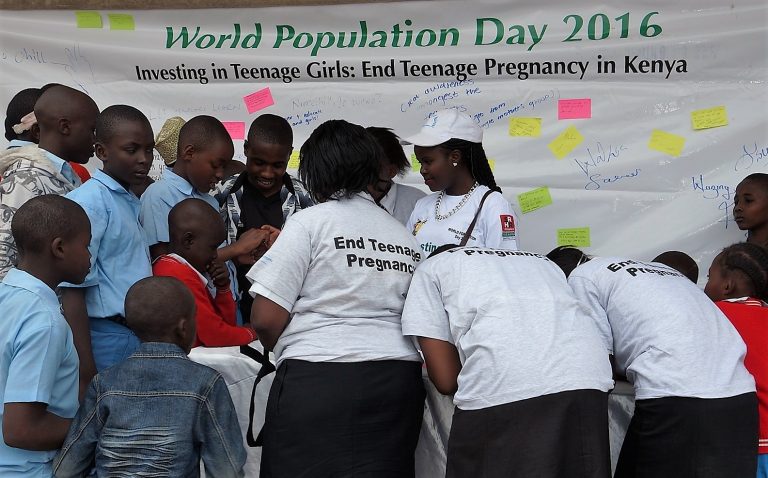
School children sign a petition during the 2016 world population day commemoration event in Nairobi, Kenya
Kenya joins the rest of the world in commemorating this year’s World Population Day at a time when the country is grappling with increasing reports of pregnancy among school going girls.
The reports of pregnant school girls highlighted by the media, are just the tip of the iceberg. Although it is difficult to give a specific number of girls who get pregnant while they are still in school, one study published by the Centre for the Study of Adolescence (CSA) estimated that 13,000 girls in Kenya leave school every year due to pregnancy.
Data from the Kenya Demographic and Health Survey 2014, reveals that many young Kenyans aged between 15 and 18 years are having babies. By age 15, 3 out of 100 girls are already child-bearing and this rises to 40 out of 100 girls by age 19.
With such astounding numbers, it is time for us take up the issue of teenage pregnancy with much more seriousness than we have so far.
The silver lining in this dark cloud is that Kenya has a favorable policy and legal framework. This policy and legal framework, if put into practice, would provide an excellent road map for solving the teenage pregnancy puzzle.
The national adolescent sexual and reproductive health policy
The most comprehensive and perhaps most relevant policy document to guide action against teenage pregnancy in Kenya is the national adolescent sexual and reproductive health policy.
The policy is very clear on what needs to be done about teenage pregnancy in Kenya. It has a 14-point action plan, ranging from providing teenagers with accurate information to facilitating youth friendly reproductive healthcare.
The policy has also identified those responsible for guiding action against teenage pregnancies in Kenya, while assigning clear roles to each player. Therefore, the policy has also answered the question of who is responsible for what.
14-point action plan
This is the time for consistent and visible action from the Ministry of Health to tackle teenage pregnancies in Kenya. The ministry needs to convene an executing team to implement the 14-point plan to tackle teenage pregnancy as outlined in the national adolescent sexual and reproductive health policy.
Teenage pregnancy, whether intended or unintended, increases the risk of death or injury of the teenage mother, including unsafe abortion, prolonged labor, complications during delivery and the post-natal period.
It’s critical for governments, both at national and county levels, to note that teenagers face greater risk of complication during pregnancy than older women and invest in preventing teenage pregnancies. This elevated risk is because teenage mothers are most likely not fully prepared for pregnancy both physiologically and biologically. Gynecological immaturity and incomplete pelvic growth have been identified as two of the risk factors for teenage mothers.
While launching the National Adolescent Sexual and Reproductive Health Policy 2015 (ASRHP) in Nairobi September 2015, the then Health Cabinet Secretary indicated that Health and education ministries were working to ensure that age-appropriate comprehensive sexuality education is implemented in all schools.
The two ministries together with other stakeholders must quickly to fulfill these promises in order to equip the teenagers with life skills to enable them delay their childbearing to an age that they are physiologically, biologically and financially prepared for pregnancy.
Dr. George Kamau is the Kenya Country Director, at Deutsche Stiftung Weltbevoelkerung (DSW). george.kamau@dswkenya.org
